The best fertilizers for feeding cucumbers in the summer in a greenhouse and open field
Cucumbers are a crop that requires constant attention. Therefore, in order to get a good harvest, the plant must, in the broad sense of the word, be provided with adequate nutrition throughout the entire period of its growth and fruiting.
To do this, you need to know how and what is the best way to feed and fertilize cucumbers in the open field or in a greenhouse during the entire growing season.

Content
Rules and methods for feeding cucumbers
- Cucumbers respond well to organic feeding ... Accordingly, when using mineral fertilizers need them combine (alternate) with organic.
- Cucumbers love to be fed gradually and in small amounts, but often.
However, this does not mean at all that you do not need to fill the cucumber beds well before sowing seeds or planting seedlings. It is necessary to cook and apply fertilizers, but in small quantities, because cucumbers do not like high doses of fertilizers.
The exception is superphosphate, it can and even needs to be applied at the rate or even more.
- Fertilizers for cucumbers are best applied in liquid form, in other words, do liquid root dressing (water at the root).
Moreover, it must be done without fail. after glaze or rain (otherwise liquid mineral fertilizers can burn the plant roots), in the evening or on a cloudy day.
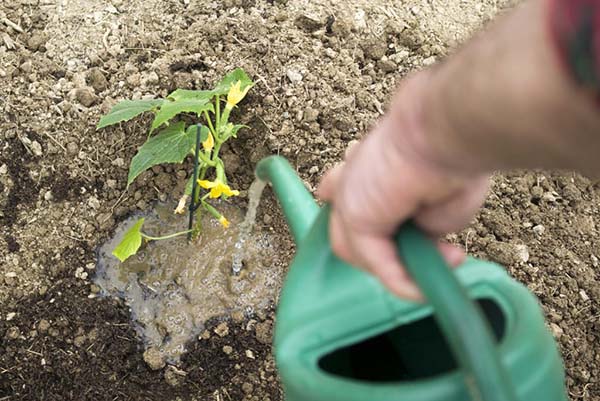
- Cucumbers also respond very well. for foliar feeding (spraying by leaves). This is especially true for micronutrient fertilizers (bora, calcium, magnesium).
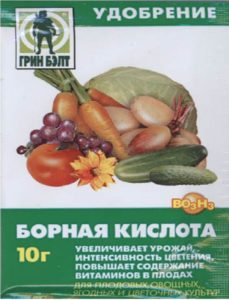
By the way! Foliar top dressing on leaves is most effective if cool cool (not hot) weather and for quite a long time the temperature was low... Under such conditions, the root system of the plant may not cope with feeding and not assimilate it, while the leaves can definitely.
In this case, spraying must be done in dry, calm weather, in the morning and evening hours. Or in the afternoonbut only in cloudy (not rainy) the weather.
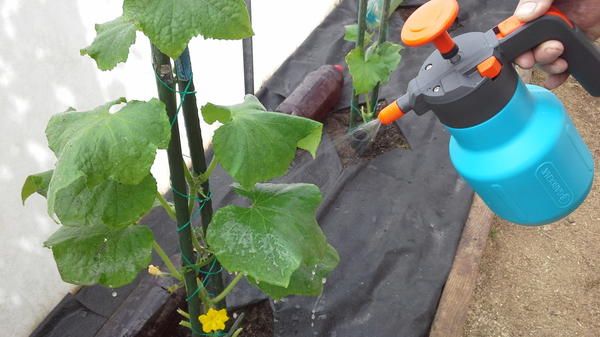
- The following fertilizers are ideal for foliar dressing (spraying on leaves): urea (nitrogen fertilizer), calcium nitrate (nitrogen-calcium), potassium monophosphate (phosphorus-potassium), magnesium sulfate, boric acid (as well as preparations "Bud", "Ovyaz"), various humates (Potassium humate or just Gumat +7).
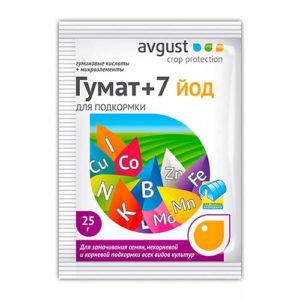
- Prepare all fertilizers (fertilizing solutions) according to the attached instructions.
- And remember: underfeeding is better than overfeeding, otherwise the plant may begin to fatten. This is especially true for nitrogen and potash fertilizers.
What fertilizers are needed for cucumbers for rapid growth and active fruiting
Cucumbers, like any plants, need all basic nutrients - nitrogen, phosphorus and potassium, as well as trace elements (especially in calcium and magnesium, as well as in bore).
And in the first place in terms of importance is potassium, then nitrogen and phosphorus.
It is also worth paying attention to the acidity of the soil: it is considered optimal pH in the range of 6.4-7 (i.e. neutral, closer to slightly alkaline). If the soil will more acidic, then the plants will show signs lack of magnesium.
Accordingly, for nitrogen feeding cucumbers does not fit such a mineral fertilizer as ammonium sulfate.
Naturally, at each stage of development of cucumbers, they need a different diet (the ratio of nutrients), which means certain fertilizers.
The lack of nutrition (certain macro and microelements) is very easy to determine by the state of the bushes and the cucumber fruits themselves (they become crooked, empty).
By the way! More details, why do cucumbers crochet or look like a light bulb (become clavate or pear-shaped), read in this material.
About the reasons why do cucumbers grow empty inside — in this article.
What and when to feed cucumbers: a feeding scheme by stages of growth (vegetation)
As a rule, cucumbers are fed according to the following scheme:
- Stage 1 - after disembarkation, preliminary home-grown seedlings in open ground (after 10-14 days) or during the period when 5-6 true leaves appear (if you sowed cucumbers with seeds directly into the ground);
- Stage 2 - during budding and the beginning of flowering (2 dressings will be enough, one root and one foliar - boron);
- Stage 3 - during fruiting (feeding every 7-10 days);
- Stage 4 - to extend the fruiting period (every 3-5 days).
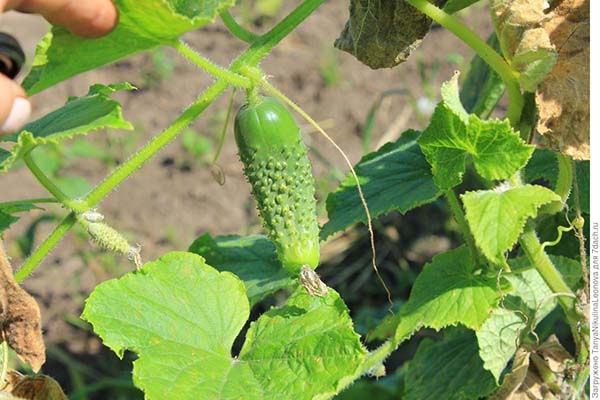
After planting seedlings in open ground or greenhouse
When the cucumber seedlings finally take root in a new place (after 10-14 days) and begin to gain green mass, they will need a lot nitrogen for a quick start growth of cucumber lashes and leaves (the green mass of the plant, they also say the stem-leaf mass).
Note! It is assumed that you initially sowed seeds or planted seedlings in already fertile soil, i.e. prepared a bed in advance and introduced all the necessary nutrients into the soil. Including phosphorus (phosphate fertilizers), which is especially needed by plants in the initial period of growth and rooting in a new place. In the future, the need for cucumbers for phosphorus decreases, because, as you know, phosphorus fertilizers dissolve in the soil slowly and plants can receive initially laid phosphorus nutrition for a fairly long time - almost until the end of the growing season. Moreover, if you regularly feed the cucumbers with wood ash, then additional fertilizing with phosphorus fertilizer (the same superphosphate) is not required.
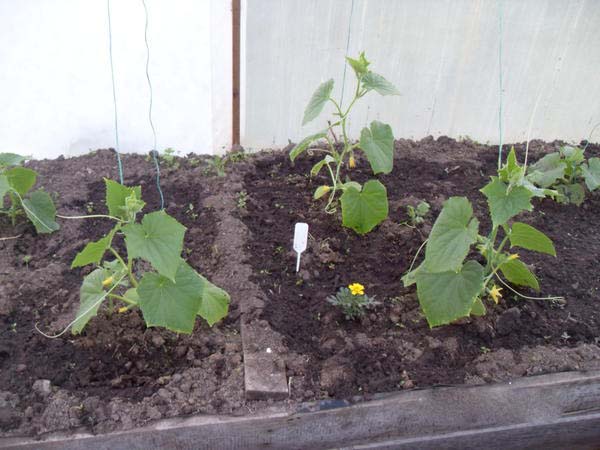
So, you can feed the cucumbers after planting in open ground with the following nitrogen fertilizers:
- solutions (infusions) of organic fertilizers: herbal infusion, solution / infusion of chicken droppings, mullein;

- solutions of mineral fertilizers: urea, ammonium or calcium nitrate.
It will be absolutely great if first nitrogen fertilization you will give exactly calcium nitrate, which contains not only a lot of nitrogen, but also a sufficient amount calcium.
During budding and flowering
At this stage, cucumbers need fertilizers that would stimulate fruit setting, in other words, increase the number of ovaries, which means they will need more potassium. But one should not forget about nitrogen, as well as about phosphorus.
From microfertilizers during this period it is very important to give top dressing boron (for better tying and pollination).
In other words, you need to do one comprehensive top dressing (potassium-nitrogen-phosphorus) and one top dressing boron.
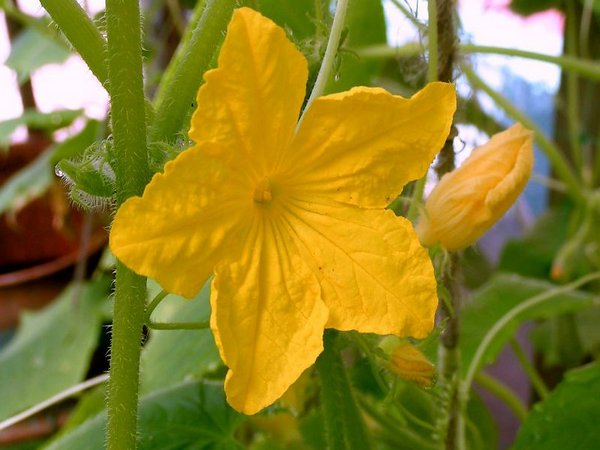
Thus, the following fertilizers are suitable for feeding cucumbers during flowering:
Advice! Most convenient to use complex mineral fertilizers type nitroammophos (all batteries 16% each).
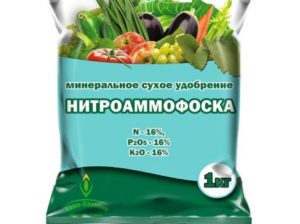
- Organic: wood ash (potassium, some phosphorus and other trace elements, but no nitrogen at all);
- Mineral: potassium sulfate / potassium sulfate (potassium), superphosphate (phosphorus), ammonium nitrate or urea (both nitrogen);
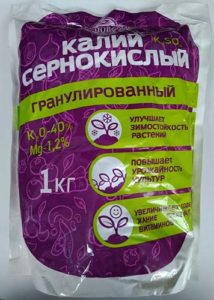
- To improve tying - boron (boric acid).
Note! It is better to use a powder rather than a liquid alcoholic tincture of boric acid.

Similar to boric acid, you can use drugs "Bud" and "Ovary".
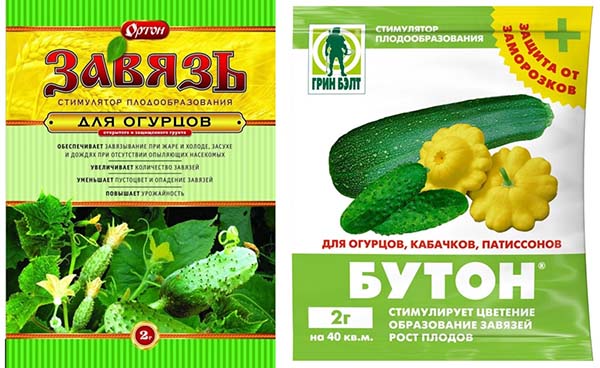
During fruiting
When cucumbers begin to actively bear fruit, they will need a regular complex nitrogen-phosphorus-potassium feed (and it is desirable that there is more potassium, sufficient nitrogen, and very little phosphorus).
Feeding cucumbers during fruiting is performed every 7-10 days after or in conjunction with watering.
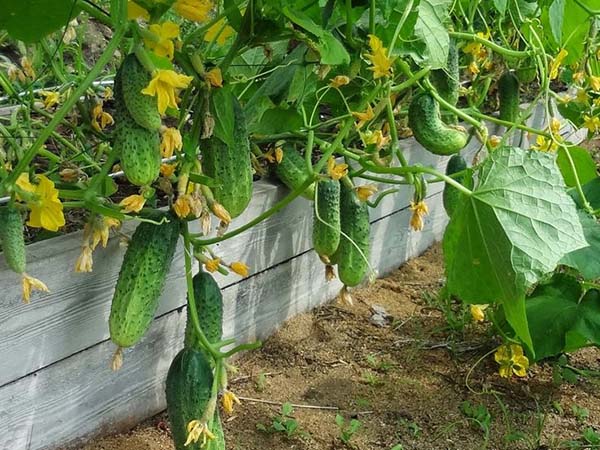
Again, it is most convenient to do complex feeding appropriate mineral fertilizers such as nitroammophos either use special ready-made fertilizers for cucumbers (squash, squash, pumpkin, in short, pumpkin crops).

However, you can combine certain organic and mineral fertilizers (thereby making up the right proportions):
- Nitrogen feeding - herbal infusion, infusion of chicken manure or mullein (All this is organic!), Solution of urea or ammonium nitrate (mineral fertilizer).
- Nitrogen-calcium - calcium nitrate solution (mineral).
Just 1 feeding with calcium nitrate is enough (maximum - 2). Therefore, if you do it at an early stage, then during the flowering and fruiting period you can no longer use, but use other nitrogen fertilizers (for example, nitrogen-potassium - potassium nitrate).
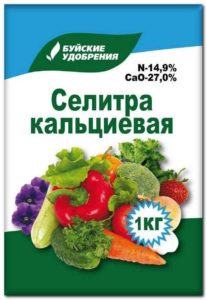
- Nitrogen-potassium - a solution of potassium (potassium) nitrate (mineral).
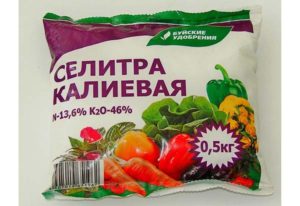
- Potassium-magnesium - potassium magnesium solution (mineral).
It will be quite enough if you make at least 1 (maximum 1) feeding with potassium magnesium (preferably at the beginning of fruiting).
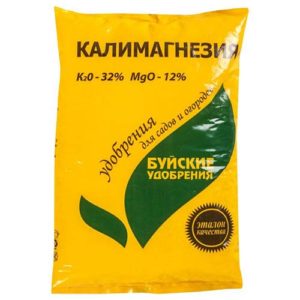
- Potassium phosphoric - solution wood ash, (organic), potassium monophosphate (mineral).
Note! If you use wood as a potassium-phosphorus top dressing, then even that small phosphorus content will be enough for cucumbers.
- Potassium - potassium sulfate solution (mineral);
- Phosphoric - superphosphate extract solution (mineral).
A maximum of 1 feeding with infusion (extract) of superphosphate is enough.
Also, if necessary, you can make additional feeding separately. boron - boric acid (if the cucumbers do not fit well), magnesium - magnesium sulfate, humate (including potassium humate).
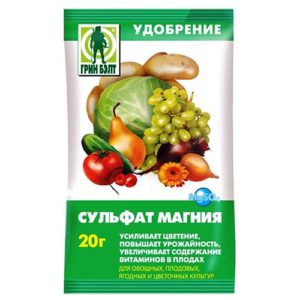
To prolong fruiting in August-September
At the end of summer, cucumbers begin to bear less fruit. This is influenced by the weather, it becomes cooler (especially at night), there is fog in the morning, and it often rains.
To extend the fruiting period of cucumbers until autumn, you need to feed them more often and more abundantly with potash and nitrogen fertilizers.
- So, feeding wood ash can be given every 5-7 dayswhile doing more concentrated and saturated solution (for example, 200-400 grams of ash per 10 liters).
Similarly, you can carry out foliar dressing with a solution potassium sulfate or better yet (But more expensive!) potassium monophosphate.
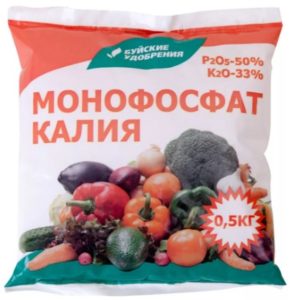
- Green fertilizer (herbal infusion) you can even give every day (or every other day), fully combining with irrigation. The same applies to feeding with infusion of hay, fermented mullein (chicken droppings).
By the way! Top dressing with a solution of wood ash can be mixed (done at the same time) with green fertilizer.
- You can also spray cucumber bushes succinic acid (1-2 grams per 10 liters of water).
Advice! Succinic acid can be added to hay infusion.

- It will not be superfluous to spend spraying with trace elements, for example, such a complex fertilizer as Humate 7 + Iodine. Or you can independently prepare a complex fertilizing from such micronutrients as magnesium sulfate, boric acidand also add calcium nitrate (nitrogen-calcium macrofertilizer).
The best organic cucumber dressings: how to prepare them and when to apply
If everything is clear with mineral fertilizers: they need to be prepared and applied in accordance with the instructions attached to the pack, then with organic, they also say folk remedies for feeding cucumbers, not everything is so simple: they still need to be prepared on their own in the correct proportion. Let's figure it out!
Wood ash
Feeding cucumbers with ash is almost the most effective fertilizer (in birch ash up to 10-12% potassium, 4-6% phosphorus, 30-40% calcium and other trace elements, including magnesium and boron, but no nitrogen), which can be applied virtually from the very beginning of the flowering of the plant every 7-10 days (especially during the fruiting period).
Moreover, dusting plants with ash helps in the fight against many pests of cucumbers - aphids, spider mite, and slugs and snails... However, it must be admitted that tobacco dust - more effective.
So to cook wood ash solution for liquid feeding of cucumbers, you need to take 1-2 glasses of ash (100-200 grams) and dilute in 10 liters of water. Then pour at the root at the rate of 3-5 liters of ash solution per 1 sq. meter of cucumber garden or 0.5-2 liters per plant.
If you want to increase solubility connections calcium, magnesium, iron and other trace elements when using an ash solution, then it should add acetic acid (50-100 ml of 9% vinegar per 10 liters of solution).
By the way! More about how to use wood ash in the garden, told in this separate article.
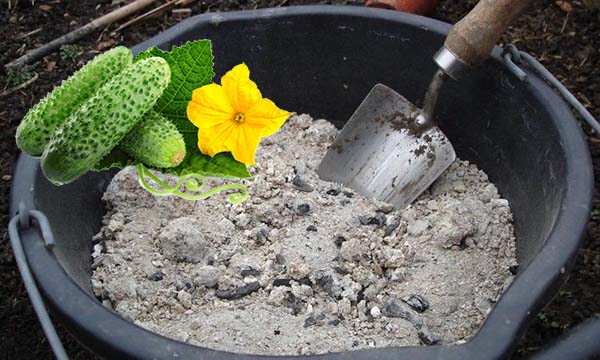
Wood ash can be used as dry (just sprinkle a handful of ash near the plant before watering)and for foliar top dressing (spraying on the leaves), only in this case the concentration of the solution should be 2 times less, that is, for 10 liters of water 1 / 2-1 glass of ash or 50-100 grams.
Note! The ash solution must not be mixed with such nitrogen fertilizer as ammonium nitrate, since this will leadto the loss of ammonia (nitrogen) and highlightingunpleasant odor (which in turn can provokeammonia plant poisoning).
The same applies to organic fertilizers (various droppings, manure, green and hay infusions).
However, if you add 50-100 ml of 9% vinegar to the ash solution, you can extinguish its excessively alkaline reaction, which means you can mix it with any organic fertilizers.
Also ash should not be mixed with superphosphate (because of this, the absorption of phosphates by plants will decrease).
Therefore, you need to divide the feeding in time.
Infusion of rotten hay
When foliar spraying, hay infusion is well suited to prolong the fruiting of cucumbers. To prepare it, you need to fill the dead hay with water in equal proportions and let it brew for a couple of days (or better even up to a week).
By the way! This infusion also shows high efficiency in protecting cucumber plantings from powdery mildew.
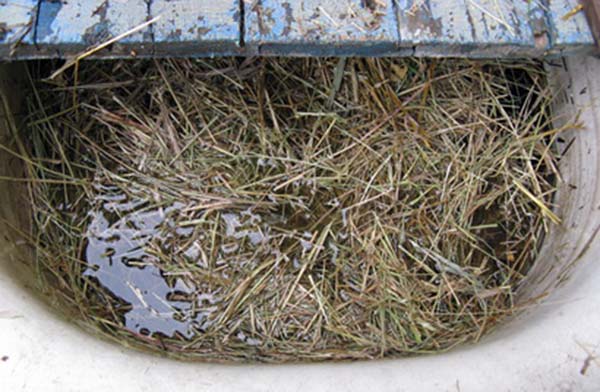
Herbal infusion or green fertilizer
To prepare an herbal infusion for feeding cucumbers, you need to fill any container with any green grass (weeds, nettles, tops, freshly cut lawn grass) and fill it with water. Let it brew for at least 2-3 days or a week - until fermentation. Before use, dilute 1 to 5 with water and add 3-5 liters of solution per square meter. meter. beds.
Green fertilizer can be used from the very beginning of the growing season until the end of fruiting.
Fermented Mullein Flask
Infusion of mullein for feeding cucumbers is done as follows: for 10 liters, 2 kg of fresh cow dung is taken (i.e. 1 part of manure and 5 parts of water). Fermentation takes about 1-2 weeks. Further, the infusion is diluted in a ratio of 1 to 10: 1 liter of the resulting infusion per 10 liters. water. Liquid root dressing is carried out on the basis of 1 liter of fertilizer per 1 cucumber bush.
You can fertilize cucumbers with mullein infusion from the very beginning of the growing season to the end of fruiting.
Similarly to cow dung, chicken manure can be used, but in the future it is better to breed in a ratio of 1 to 15.

If you want your cucumber bushes to grow without problems, bloom and bear fruit abundantly, organize the right feeding for them, and they will undoubtedly reward you with a truly cosmic harvest of tasty greens.
Video: when and how to feed cucumbers in a greenhouse


I really liked the selection of material. As a beginner gardener, I learned a lot of useful things. Many thanks.